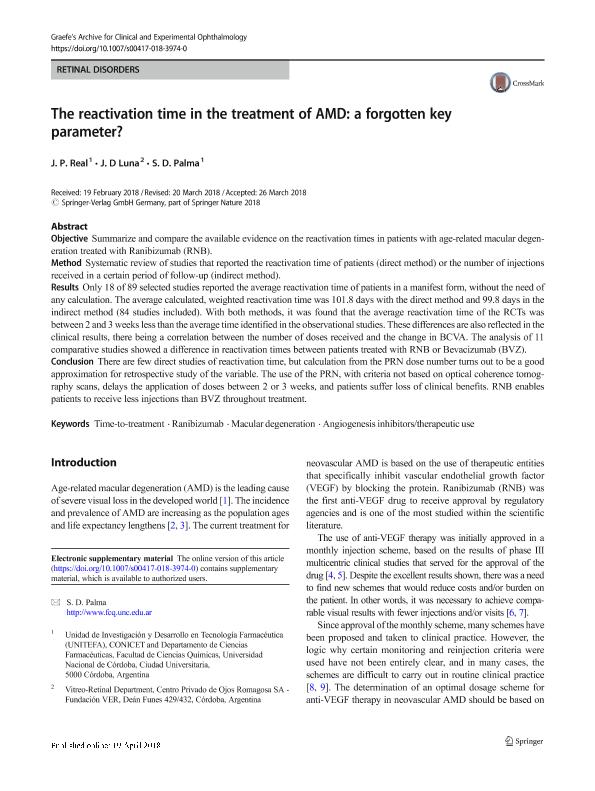Mostrar el registro sencillo del ítem
dc.contributor.author
Real, Juan Pablo

dc.contributor.author
Luna, J. D.
dc.contributor.author
Palma, Santiago Daniel

dc.date.available
2023-01-27T20:09:53Z
dc.date.issued
2018-06
dc.identifier.citation
Real, Juan Pablo; Luna, J. D.; Palma, Santiago Daniel; The reactivation time in the treatment of AMD: a forgotten key parameter?; Springer; Graefes Archive For Clinical And Experimental Ophthalmology; 256; 6; 6-2018; 1079-1087
dc.identifier.issn
0721-832X
dc.identifier.uri
http://hdl.handle.net/11336/186007
dc.description.abstract
Objective: Summarize and compare the available evidence on the reactivation times in patients with age-related macular degeneration treated with Ranibizumab (RNB). Method: Systematic review of studies that reported the reactivation time of patients (direct method) or the number of injections received in a certain period of follow-up (indirect method). Results: Only 18 of 89 selected studies reported the average reactivation time of patients in a manifest form, without the need of any calculation. The average calculated, weighted reactivation time was 101.8 days with the direct method and 99.8 days in the indirect method (84 studies included). With both methods, it was found that the average reactivation time of the RCTs was between 2 and 3 weeks less than the average time identified in the observational studies. These differences are also reflected in the clinical results, there being a correlation between the number of doses received and the change in BCVA. The analysis of 11 comparative studies showed a difference in reactivation times between patients treated with RNB or Bevacizumab (BVZ). Conclusion: There are few direct studies of reactivation time, but calculation from the PRN dose number turns out to be a good approximation for retrospective study of the variable. The use of the PRN, with criteria not based on optical coherence tomography scans, delays the application of doses between 2 or 3 weeks, and patients suffer loss of clinical benefits. RNB enables patients to receive less injections than BVZ throughout treatment.
dc.format
application/pdf
dc.language.iso
eng
dc.publisher
Springer

dc.rights
info:eu-repo/semantics/openAccess
dc.rights.uri
https://creativecommons.org/licenses/by-nc-sa/2.5/ar/
dc.subject
ANGIOGENESIS INHIBITORS/THERAPEUTIC USE
dc.subject
MACULAR DEGENERATION
dc.subject
RANIBIZUMAB
dc.subject
TIME-TO-TREATMENT
dc.subject.classification
Oftalmología

dc.subject.classification
Medicina Clínica

dc.subject.classification
CIENCIAS MÉDICAS Y DE LA SALUD

dc.title
The reactivation time in the treatment of AMD: a forgotten key parameter?
dc.type
info:eu-repo/semantics/article
dc.type
info:ar-repo/semantics/artículo
dc.type
info:eu-repo/semantics/publishedVersion
dc.date.updated
2023-01-27T16:00:31Z
dc.journal.volume
256
dc.journal.number
6
dc.journal.pagination
1079-1087
dc.journal.pais
Alemania

dc.journal.ciudad
Berlin
dc.description.fil
Fil: Real, Juan Pablo. Consejo Nacional de Investigaciones Científicas y Técnicas. Centro Científico Tecnológico Conicet - Córdoba. Unidad de Investigación y Desarrollo en Tecnología Farmacéutica. Universidad Nacional de Córdoba. Facultad de Ciencias Químicas. Unidad de Investigación y Desarrollo en Tecnología Farmacéutica; Argentina
dc.description.fil
Fil: Luna, J. D.. Fundación Ver; Argentina
dc.description.fil
Fil: Palma, Santiago Daniel. Consejo Nacional de Investigaciones Científicas y Técnicas. Centro Científico Tecnológico Conicet - Córdoba. Unidad de Investigación y Desarrollo en Tecnología Farmacéutica. Universidad Nacional de Córdoba. Facultad de Ciencias Químicas. Unidad de Investigación y Desarrollo en Tecnología Farmacéutica; Argentina
dc.journal.title
Graefes Archive For Clinical And Experimental Ophthalmology

dc.relation.alternativeid
info:eu-repo/semantics/altIdentifier/url/http://link.springer.com/10.1007/s00417-018-3974-0
dc.relation.alternativeid
info:eu-repo/semantics/altIdentifier/doi/http://dx.doi.org/10.1007/s00417-018-3974-0
Archivos asociados
